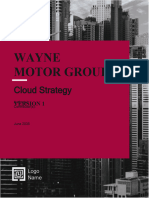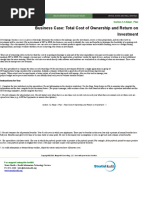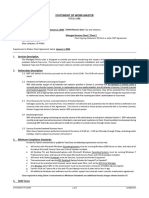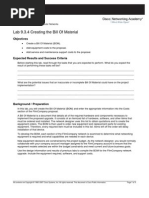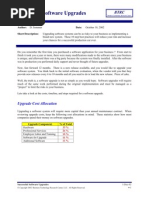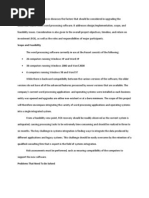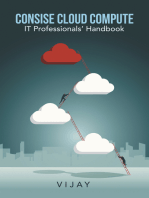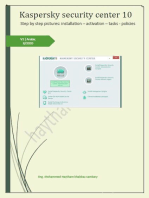General Instruction Manual: Accounting For The Costs of Computer Software Developed or Obtained For Internal Use Content
General Instruction Manual: Accounting For The Costs of Computer Software Developed or Obtained For Internal Use Content
Uploaded by
Aldrien CabinteCopyright:
Available Formats
General Instruction Manual: Accounting For The Costs of Computer Software Developed or Obtained For Internal Use Content
General Instruction Manual: Accounting For The Costs of Computer Software Developed or Obtained For Internal Use Content
Uploaded by
Aldrien CabinteOriginal Title
Copyright
Available Formats
Share this document
Did you find this document useful?
Is this content inappropriate?
Copyright:
Available Formats
General Instruction Manual: Accounting For The Costs of Computer Software Developed or Obtained For Internal Use Content
General Instruction Manual: Accounting For The Costs of Computer Software Developed or Obtained For Internal Use Content
Uploaded by
Aldrien CabinteCopyright:
Available Formats
SAUDI ARABIAN OIL COMPANY (Saudi Aramco) GENERAL INSTUCTION NO.
GENERAL INSTRUCTION MANUAL 202.320
ISSUE DATE REPLACES
ISSUING ORG. ACCOUNTING POLICY, METHODS & SYSTEMS DEPARTMENT 01-05-2000 New
APPROVAL PAGE NO.
SUBJECT
Accounting for the Costs of Computer Software Developed or
Obtained for Internal Use AMZ 1 OF 9
CONTENT
This instruction stipulates the appropriate accounting treatment for costs incurred for the purchase or
development of software to be used by Saudi Aramco. It includes the following sections:
1. Background
2. Scope
3. Stages of Computer Software Development
4. Costs to be Expensed as Incurred
5. Costs Required to be Capitalized
6. Amortization of Capitalized Costs
7. Additional Policy Considerations
8. Accounting
Attachment I - Decision Table
1. BACKGROUND
In March 1998, the U.S. Accounting Standards Executive Committee (AcSEC) issued
Statement of Position (SOP) 98-1, Accounting for the Costs of Computer Software Developed or
Obtained for Internal Use, which has an effective date for Saudi Aramco of January 1, 1999.
Additionally, the Financial Accounting Standards Board Emerging Issues Task Force (EITF)
has issued two pronouncements providing guidance on the accounting for costs incurred relative
to information technology; EITF 96-14, Accounting for the Costs Associated with Modifying
Computer Software for the Year 2000, and EITF 97-13, Accounting for Costs Incurred in
Connection with a Consulting Contract or an Internal Project That Combines Business Process
Reengineering and Information Technology Transformation. This accounting policy is intended
to encompass the requirements contained in these pronouncements.
Prior to issuance of the above pronouncements, U.S. Generally Accepted Accounting Principles
(GAAP) contained little guidance on the accounting for computer software developed or
obtained for internal use. AcSEC has concluded that certain software purchase or development
activities create probable future economic benefits and that the related costs should be
capitalized as intangible assets and amortized over the estimated useful life of the software.
Consistent with most large corporations that follow US GAAP, Saudi Aramco has typically
expensed the costs of purchasing or developing software as they were incurred. Therefore, this
new accounting policy will represent a significant change in classification of costs incurred for
software projects or purchases that fall within its scope as outlined in Section 2 below. The
policy change will result in large software costs being allocated over the years that Saudi
Aramco benefits from the new software, as opposed to being recognized as expense
immediately.
* CHANGE ** ADDITION NEW INSTRUCTION COMPLETE REVISION
SAUDI ARABIAN OIL COMPANY (Saudi Aramco) GENERAL INSTUCTION NO.
GENERAL INSTRUCTION MANUAL 202.320
ISSUE DATE REPLACES
ISSUING ORG. ACCOUNTING POLICY, METHODS & SYSTEMS DEPARTMENT 01-05-2000 New
APPROVAL PAGE NO.
SUBJECT
Accounting for the Costs of Computer Software Developed or
Obtained for Internal Use AMZ 2 OF 9
2 SCOPE
This policy is effective January 1, 1999 for each project/purchase contract where total costs for
a particular type of software are expected to reach $2 million or more and have an estimated
useful life of three or more years. Such software purchases or projects should be budgeted for,
and funded by, either stand-alone or Master Appropriation Capital Budget Items. Exceptions
include:
; Internal-use software used in research and development activities (e.g., laboratory,
exploration or petroleum engineering research and development activities) or software
that represents a pilot project – accounting treatment will continue to be dictated by
Financial Accounting Standards Board Statement (FASB) No. 2, Accounting for
Research and Development Costs.
; Software to be sold, leased or otherwise marketed – accounting treatment will continue to
be dictated by FASB No. 86, Accounting for the Costs of Computer Software to Be Sold,
Leased, or Otherwise Marketed.
For projects begun prior to January 1, 1999, software costs previously expensed will not be
adjusted to amounts that would have been capitalized had this policy been in effect when those
costs were incurred.
3. STAGES OF COMPUTER SOFTWARE DEVELOPMENT
The following table illustrates the various stages and related processes typically associated with
computer software development projects to assist with the classification of the software costs in
accordance with Sections 4 and 5. It is recognized that the development of internal use software
may not follow the order shown below. For costs incurred subsequent to the Preliminary
Project Stage, the capital and expense guidelines contained herein should be applied based on
the nature of the costs incurred, not the timing of their incurrence.
Post-Implementation/
Preliminary Project Stage Application Development Operation Stage
(Expense) Stage (Capital) (Expense)
- Conceptual formulation of - Design of chosen path, - Training
alternatives including software - Application Maintenance
- Evaluation of alternatives configuration & interfaces
- Determination of existence - Coding
of needed technology - Installation to hardware
- Final selection of - Testing, including parallel
alternatives processing phase
* CHANGE ** ADDITION NEW INSTRUCTION COMPLETE REVISION
SAUDI ARABIAN OIL COMPANY (Saudi Aramco) GENERAL INSTUCTION NO.
GENERAL INSTRUCTION MANUAL 202.320
ISSUE DATE REPLACES
ISSUING ORG. ACCOUNTING POLICY, METHODS & SYSTEMS DEPARTMENT 01-05-2000 New
APPROVAL PAGE NO.
SUBJECT
Accounting for the Costs of Computer Software Developed or
Obtained for Internal Use AMZ 3 OF 9
4. COSTS TO BE EXPENSED AS INCURRED
The following costs incurred in connection with software purchases or development projects are
to be expensed as they are incurred:
• The costs of any internal-use software purchase/project whose total expected costs do not
meet the scope of this policy, as described in Section 2.
• Costs incurred to modify computer software to correct year 2000 problems, except where
the costs involve the purchase of software that replaces existing software that is not year
2000 compliant.
• Preliminary Project Stage costs, such as: feasibility studies, vendor/contractor selection or
costs incurred as described in the table in Section 3 above.
• All training costs incurred, at any stage.
• General and administrative or overhead costs.
• Internal application maintenance costs. However, external costs related to maintenance,
unspecified upgrades and enhancements, and costs under agreements that combine the costs
of maintenance and unspecified upgrades and enhancements should be recognized in
expense over the contract period on a straight-line basis unless another systematic basis is
more representative of the services received. If a distinction cannot be made between
maintenance and relatively minor upgrades/enhancements, the costs should be expensed as
incurred.
• Data conversion costs, other than the costs to develop or obtain software that allows for
access to, or conversion of, old data by new systems (see Section 5 for further discussion).
• The costs of business process reengineering activities, whether done internally or by third
parties. Reengineering activities include activities such as the preparation of a request for
consulting proposal, analyzing the current business process (i.e., current state assessment),
business process reengineering or restructuring of the work force.
• All costs incurred after the computer software is substantially complete and ready for its
intended use (i.e., all substantial testing is complete).
* CHANGE ** ADDITION NEW INSTRUCTION COMPLETE REVISION
SAUDI ARABIAN OIL COMPANY (Saudi Aramco) GENERAL INSTUCTION NO.
GENERAL INSTRUCTION MANUAL 202.320
ISSUE DATE REPLACES
ISSUING ORG. ACCOUNTING POLICY, METHODS & SYSTEMS DEPARTMENT 01-05-2000 New
APPROVAL PAGE NO.
SUBJECT
Accounting for the Costs of Computer Software Developed or
Obtained for Internal Use AMZ 4 OF 9
5 COSTS REQUIRED TO BE CAPITALIZED
The following costs incurred in connection with software purchases or development projects
that meet the scope of this policy, as described in Section 2, are to be capitalized:
• Internal and external Application Development Stage project costs incurred as described in
the table in Section 3.
• External costs of materials and services consumed in obtaining/developing software. These
costs include fees paid to third parties for services provided to obtain/develop the software
during the application development stage (as defined in Section 3), costs incurred to obtain
computer software from third parties (e.g., software contracts that benefit three years or
more) and travel expenses incurred by employees in their duties directly associated with
developing software. Costs incurred to obtain software licenses are to be accounted for
similar to capital leases as described in General Instruction No. 20.161.
• The costs incurred to obtain/develop software that allows for access to, or conversion of, old
data by new systems.
• Upgrades and enhancements that will result in additional functionality – Upgrades and
enhancements are defined as modifications to existing internal-use software to enable the
software to perform tasks that it was previously incapable of performing. Upgrades and
enhancements normally require new software specifications and may also require changes to
all or part of the existing software specifications.
• Payroll and related costs, based on Saudi Aramco standard labor rates, for employees who
are directly associated with the software purchase/project. Project Managers should develop
a method of tracking or estimating internal labor cost directly associated with the project for
capitalization.
• Interest cost incurred while developing the software, consistent with the guidance contained
in Accounting Instruction No. 728, Interest Income and Expense, Section 4.
* CHANGE ** ADDITION NEW INSTRUCTION COMPLETE REVISION
SAUDI ARABIAN OIL COMPANY (Saudi Aramco) GENERAL INSTUCTION NO.
GENERAL INSTRUCTION MANUAL 202.320
ISSUE DATE REPLACES
ISSUING ORG. ACCOUNTING POLICY, METHODS & SYSTEMS DEPARTMENT 01-05-2000 New
APPROVAL PAGE NO.
SUBJECT
Accounting for the Costs of Computer Software Developed or
Obtained for Internal Use AMZ 5 OF 9
6 AMORTIZATION OF CAPITALIZED COSTS
Once the appropriate accounting treatment has been determined based on the discussion in
Sections 3, 4 and 5, the amounts that have been capitalized should be amortized as follows:
• Amortization of the obtained/developed software should begin as soon as the software is
ready for its intended use. If a computer software project is implemented based on modules,
amortization of a module should begin when it is ready for its intended use and all other
modules upon which it is functionally dependent, if any, are also ready for their intended
uses. The Project Manager or proponent should send the Mechanical Completion Certificate
to the Fixed Assets & Work-In-Progress Accounting Department (FAWIP) advising when
the software is ready for its intended use and amortization should begin.
• The capitalized costs of computer software should be amortized on a straight-line basis
unless another systematic and rational basis is more representative of the software’s use.
• The estimated useful life for computer software depends on the effects of obsolescence and
should generally correspond to the term of software license.
7 ADDITIONAL POLICY CONSIDERATIONS
In addition to the discussion in the previous sections, the following should also be considered
when applying this policy:
• When existing software is being replaced by the newly obtained/developed software,
unamortized costs of the old software, if any, should be written off when the new software is
ready for its intended use. Included with the Mechanical Completion Certificate from the
proponent or Project Manager to FAWIP regarding the beginning of amortization of the new
software, FAWIP should also be sent a Form SA-630, Capital Assets Change Authorization
(GI 207.050), stipulating when the unamortized cost of the software being replaced should be
written-off.
• When computer software is purchased from third parties and the purchase price includes
multiple elements, such as: software, training, maintenance fees, data conversion costs,
reengineering and rights to future upgrades and enhancements, the capitalizable/expense
costs should be allocated among the individual elements as stipulated in Section 8. The
allocation should be estimated by the proponent based on objective evidence of fair value of
the elements in the contract, not necessarily on the separate prices stated within the contract
for each element. If a distinction cannot be made between maintenance and relatively minor
upgrades and/or enhancements, the costs should be expensed as incurred.
* CHANGE ** ADDITION NEW INSTRUCTION COMPLETE REVISION
SAUDI ARABIAN OIL COMPANY (Saudi Aramco) GENERAL INSTUCTION NO.
GENERAL INSTRUCTION MANUAL 202.320
ISSUE DATE REPLACES
ISSUING ORG. ACCOUNTING POLICY, METHODS & SYSTEMS DEPARTMENT 01-05-2000 New
APPROVAL PAGE NO.
SUBJECT
Accounting for the Costs of Computer Software Developed or
Obtained for Internal Use AMZ 6 OF 9
• If it becomes no longer probable that the computer software project will be completed and
placed in service, no further costs should be capitalized and an analysis of the future benefit
of amounts previously capitalized should be performed. The proponent or Project Manager
should send Form SA-630 to FAWIP outlining the capitalized costs that have no future
benefit to Saudi Aramco so they can be written-off.
8 ACCOUNTING
The accounting process for capitalization of purchased/developed software is similar to the
accounting treatment for other capital projects.
• All costs, both capital and expense, will be accumulated in Type Code 60 accounts that will
consolidate to account 10-350-01, Incomplete Construction – T/C 60, in Saudi Aramco’s
General Ledger. This account is classified as Construction in Progress (CIP). The Type
Code 60 accounts should be segregated into phases representing costs that will be capitalized
and costs that will be expensed to ensure that expense items are properly cleared
automatically through voucher 95 and capital items remain in CIP until project completion.
• When the Mechanical Completion Certificate, representing the point at which the software is
ready for its intended use, has been received by FAWIP, the entries to properly reclassify the
costs included in CIP to the appropriate asset account are as follows:
In Voucher 91:
10-451-31 Misc Plant & Equip Clearances XXX
60-XXXXX-XXX Type Code 60 Account XXX
In Voucher 7:
10-380-50 Comp Sftwr Develop/Acquisition XXX
10-451-31 Misc Plant & Equipment Clearances XXX
• FAWIP will be responsible for calculating amortization on the capitalized software as
directed by the proponent or Project Manager and record the amortization as follows:
In Voucher 7:
10-877-07 Amort Exp – Comp Sftwr XXX
10-380-51 Acc Amort – Software XXX
* CHANGE ** ADDITION NEW INSTRUCTION COMPLETE REVISION
SAUDI ARABIAN OIL COMPANY (Saudi Aramco) GENERAL INSTUCTION NO.
GENERAL INSTRUCTION MANUAL 202.320
ISSUE DATE REPLACES
ISSUING ORG. ACCOUNTING POLICY, METHODS & SYSTEMS DEPARTMENT 01-05-2000 New
APPROVAL PAGE NO.
SUBJECT
Accounting for the Costs of Computer Software Developed or
Obtained for Internal Use AMZ 7 OF 9
• When capitalized software is being replaced or retired, the proponent should prepare Form
SA-630 for FAWIP outlining the asset being replaced or retired. The entries required to be
made by FAWIP are as follows:
In Voucher 7:
10-380-51 Acc Amort – Software XXX
427-460 Loss on Software Write-Off XXX
10-380-50 Comp Sftwr Develop/Acquisition XXX
Approved by: ____________________
Abdulla M. Zahia, Manager
Accounting Policy, Methods &
Systems Department
MJH
W/C #P134
* CHANGE ** ADDITION NEW INSTRUCTION COMPLETE REVISION
SAUDI ARABIAN OIL COMPANY (Saudi Aramco) GENERAL INSTUCTION NO.
GENERAL INSTRUCTION MANUAL 202.320
ISSUE DATE REPLACES
ISSUING ORG. ACCOUNTING POLICY, METHODS & SYSTEMS DEPARTMENT 01-05-2000 New
APPROVAL PAGE NO.
SUBJECT
Accounting for the Costs of Computer Software Developed or
Obtained for Internal Use AMZ 8 OF 9
Attachment I
The decision table below can be used to assist Saudi Aramco organizations in determining the proper
accounting treatment for software costs in accordance with this policy:
Expense As
Description of Activity Incurred Capitalize
Purchase/Development Projects whose total costs < $2 million
or benefits < 3 years X
Y2K Related:
Costs incurred to replace software not Y2K compliant (see
other elements of this table to determine which costs should
be capitalized) X
All other Y2K related software costs X
Business Process Re-engineering:
Preparation of request for consulting proposal X
Analyzing current business process X
Process re-engineering X
Restructuring the workforce X
Preliminary Project Stage Costs:
Feasibility study X
Vendor/contractor selection X
Conceptual formulation, evaluation and selection of
alternatives X
Training Costs (any stage) X
Application Maintenance:
Maintenance only (internal or external) X
Unspecified upgrades or enhancements bundled with
maintenance (if distinction can be made) X
Data Conversion Costs:
Costs to develop software that allows for access to, or
conversion of, old data by new systems (see other
elements of this table to determine which costs should be
capitalized) X
Other data conversion costs X
* CHANGE ** ADDITION NEW INSTRUCTION COMPLETE REVISION
SAUDI ARABIAN OIL COMPANY (Saudi Aramco) GENERAL INSTUCTION NO.
GENERAL INSTRUCTION MANUAL 202.320
ISSUE DATE REPLACES
ISSUING ORG. ACCOUNTING POLICY, METHODS & SYSTEMS DEPARTMENT 01-05-2000 New
APPROVAL PAGE NO.
SUBJECT
Accounting for the Costs of Computer Software Developed or
Obtained for Internal Use AMZ 9 OF 9
Expense As
Description of Activity Incurred Capitalize
Application Development Stage Costs:
Design of chosen path X
Software configuration and interface design X
Coding X
Installation to hardware and testing X
Payroll & payroll related costs (using SAOC standard labor
rates) X
Other Costs Incurred in Obtaining/Developing Software:
Costs to obtain software from 3rd Parties X
Costs incurred under contracts that benefit only one year X
Travel costs directly associated with developing software X
Costs Incurred After Software is Ready for Intended Use X
MJH
W/C #P134
* CHANGE ** ADDITION NEW INSTRUCTION COMPLETE REVISION
You might also like
- 4 - WMG-Cloud-Strategy-TemplateDocument8 pages4 - WMG-Cloud-Strategy-TemplatesamsonadebogaNo ratings yet
- Deloitte Uk Capitalising Your Cloud BookletDocument12 pagesDeloitte Uk Capitalising Your Cloud Bookletng kk100% (1)
- Co Blue PrintDocument52 pagesCo Blue PrintBewqetu SewMehone100% (1)
- REVPRO 3.0 ASC606 ConfigurationBRDDocument32 pagesREVPRO 3.0 ASC606 ConfigurationBRDBeverly Baker-HarrisNo ratings yet
- 1.2TCO and ROIDocument12 pages1.2TCO and ROIasepNo ratings yet
- General Instruction ManualDocument7 pagesGeneral Instruction ManualAkash K NairNo ratings yet
- Accounting For WebDocument11 pagesAccounting For WebHer MasturNo ratings yet
- Ey Gaap Weekly Update 2018 09 06Document6 pagesEy Gaap Weekly Update 2018 09 06ronynoorNo ratings yet
- Final Project Report Group 2Document11 pagesFinal Project Report Group 2Kishan RawatNo ratings yet
- A Closer Look - Software-As-A-Service ArrangementsDocument12 pagesA Closer Look - Software-As-A-Service ArrangementsMaureen Grace GonzalesNo ratings yet
- Triniti MDM Business Case & ROI Analysis Tech Company ExampleDocument72 pagesTriniti MDM Business Case & ROI Analysis Tech Company Examplerama111No ratings yet
- Reimagining Energy Trading and Risk Management ETRM With Advanced Delivery and SupportDocument9 pagesReimagining Energy Trading and Risk Management ETRM With Advanced Delivery and SupportCTRM CenterNo ratings yet
- PHP Project (BHCS)Document17 pagesPHP Project (BHCS)Shubham KumarNo ratings yet
- Spotlight Accounting For Cloud Based Software PDFDocument4 pagesSpotlight Accounting For Cloud Based Software PDFSanele MbokaziNo ratings yet
- Preparing For Regulated Automotive Over-The-Air UpdatesDocument15 pagesPreparing For Regulated Automotive Over-The-Air UpdatesyachengzhouNo ratings yet
- Test File 3Document9 pagesTest File 3rashmimohapatra2025No ratings yet
- Odoo Implementation Proposal -Asl Altamayoz Trading Est -V1Document10 pagesOdoo Implementation Proposal -Asl Altamayoz Trading Est -V1shanafzal.khanNo ratings yet
- Measuring Return On Investment of Model-Based Design: by Joy Lin, Aerospace Industry Marketing Manager, MathworksDocument6 pagesMeasuring Return On Investment of Model-Based Design: by Joy Lin, Aerospace Industry Marketing Manager, MathworksdepriyankaNo ratings yet
- Financial Control Over It-Budgeting and Cost ControlDocument23 pagesFinancial Control Over It-Budgeting and Cost ControlAlemor AlviorNo ratings yet
- Statement of Work Master: 1. Services DescriptionDocument4 pagesStatement of Work Master: 1. Services DescriptionsaitNo ratings yet
- Audit, Develop and ImplementDocument8 pagesAudit, Develop and ImplementVishal MadooNo ratings yet
- Development of Passenger Information System, Fuel Monitoring & Vehicle Tracking SystemDocument6 pagesDevelopment of Passenger Information System, Fuel Monitoring & Vehicle Tracking SystemRamprasad NagarajaNo ratings yet
- Agile Accounting OverviewDocument5 pagesAgile Accounting OverviewAmrita AroraNo ratings yet
- Creating The Bill of MaterialDocument3 pagesCreating The Bill of Materialonlycisco.tkNo ratings yet
- Guidewire Upgrade FactoryDocument12 pagesGuidewire Upgrade FactoryVenkatesh Venky DabbaraNo ratings yet
- SPD RFP Single Stage Information Systems July 2023Document338 pagesSPD RFP Single Stage Information Systems July 2023richard nagassarNo ratings yet
- Security Patches IecDocument533 pagesSecurity Patches IecAkram M. AlmotaaNo ratings yet
- Case 3-Group5-EDS CaseDocument3 pagesCase 3-Group5-EDS CaseMohanapriya JayakumarNo ratings yet
- Project Organization StructureDocument47 pagesProject Organization StructuresemereNo ratings yet
- IT Software Capitalization: 1. Phases of Computer Software Development For Capitalizable SoftwareDocument5 pagesIT Software Capitalization: 1. Phases of Computer Software Development For Capitalizable SoftwareSanele MbokaziNo ratings yet
- Security Patches IecDocument543 pagesSecurity Patches Iecrafa.calle.rossellNo ratings yet
- Mapping Document of SAMAC and 19770 1 - 2017 by 19770 8Document23 pagesMapping Document of SAMAC and 19770 1 - 2017 by 19770 8Jenny Arteaga JaimesNo ratings yet
- Successful Software UpgradesDocument4 pagesSuccessful Software UpgradesmailtopvvkNo ratings yet
- Introduction of Shopping MartDocument8 pagesIntroduction of Shopping MartShikhar GuptaNo ratings yet
- Matrix Dot NetDocument3 pagesMatrix Dot NetSam MustNo ratings yet
- L1-NAM-INS-027 - Signalling CBI Data Submission RequirementsDocument8 pagesL1-NAM-INS-027 - Signalling CBI Data Submission Requirements4493464No ratings yet
- G1NTI ITC1 BS08 Managed Service v0.1Document8 pagesG1NTI ITC1 BS08 Managed Service v0.1Burzes BatliwallaNo ratings yet
- MDMS - Technical - Agreement - For - 11 Lacs - Smart - MetersDocument35 pagesMDMS - Technical - Agreement - For - 11 Lacs - Smart - MetersKrishnakanth VankayalapatiNo ratings yet
- Ch07 PPTDocument41 pagesCh07 PPTBurime GrajqevciNo ratings yet
- Technical Details For Digital Laboratory Information Management SoftwareDocument10 pagesTechnical Details For Digital Laboratory Information Management Softwaresrikant ramanNo ratings yet
- Business Guidance Note 10 - Software CapitalisationDocument2 pagesBusiness Guidance Note 10 - Software CapitalisationImranShaikhNo ratings yet
- Service Definition Document 2022 05 18 0945Document6 pagesService Definition Document 2022 05 18 0945hp130719No ratings yet
- Defense Innovation Board Ten Commandments of Software: Executive SummaryDocument6 pagesDefense Innovation Board Ten Commandments of Software: Executive Summarysoultadu0% (1)
- Quality Cost and TypesDocument4 pagesQuality Cost and Typeskalabhali609No ratings yet
- Test Plan TemplateDocument8 pagesTest Plan Templatemurtajiz110No ratings yet
- Enterprise Management: Release GuideDocument21 pagesEnterprise Management: Release Guidekhemiri RawiaNo ratings yet
- Araxxe Whitepaper Buy or Subscribe 20180212023134Document16 pagesAraxxe Whitepaper Buy or Subscribe 20180212023134abdullaNo ratings yet
- Lta 1Document5 pagesLta 1Sheenkai KilpatrickNo ratings yet
- Usage Based Milestone Billings V1Document76 pagesUsage Based Milestone Billings V1Danesh ThangarajNo ratings yet
- Cyb Sec Guideline V02 01 enDocument47 pagesCyb Sec Guideline V02 01 enROBYNo ratings yet
- Computer-Assisted Audit Techniques (CAATs)Document5 pagesComputer-Assisted Audit Techniques (CAATs)Esther Wanjuki100% (1)
- Tutorial 2Document2 pagesTutorial 2VENKATESH UNo ratings yet
- Tutorial 2Document2 pagesTutorial 2rishabhNo ratings yet
- IATF 16949 Webinar Slides 3.7.17 Final PDFDocument47 pagesIATF 16949 Webinar Slides 3.7.17 Final PDFmilou88No ratings yet
- Book Series Increasing Productivity of Software Development, Part 2: Management Model, Cost Estimation and KPI ImprovementFrom EverandBook Series Increasing Productivity of Software Development, Part 2: Management Model, Cost Estimation and KPI ImprovementNo ratings yet
- Software Testing Interview Questions You'll Most Likely Be AskedFrom EverandSoftware Testing Interview Questions You'll Most Likely Be AskedNo ratings yet
- Securing Application Deployment with Obfuscation and Code Signing: How to Create 3 Layers of Protection for .NET Release BuildFrom EverandSecuring Application Deployment with Obfuscation and Code Signing: How to Create 3 Layers of Protection for .NET Release BuildNo ratings yet
- Content:: Saudi Arabian Oil Company (Saudi Aramco) General Instruction ManualDocument13 pagesContent:: Saudi Arabian Oil Company (Saudi Aramco) General Instruction ManualAldrien CabinteNo ratings yet
- Content:: Saudi Arabian Oil Company (Saudi Aramco) General Instruction ManualDocument10 pagesContent:: Saudi Arabian Oil Company (Saudi Aramco) General Instruction ManualAldrien CabinteNo ratings yet
- General Instruction Manual: Saudi Arabian Oil Company (Saudi Aramco)Document5 pagesGeneral Instruction Manual: Saudi Arabian Oil Company (Saudi Aramco)Aldrien CabinteNo ratings yet
- General Instruction Manual: 1. GlossaryDocument13 pagesGeneral Instruction Manual: 1. GlossaryAldrien CabinteNo ratings yet
- Content:: G. I. NumberDocument23 pagesContent:: G. I. NumberAldrien CabinteNo ratings yet
- Trenching Safety Tailgate TopicsDocument1 pageTrenching Safety Tailgate TopicsAldrien CabinteNo ratings yet
- Content:: Saudi Arabian Oil Company (Saudi Aramco) General Instruction ManualDocument2 pagesContent:: Saudi Arabian Oil Company (Saudi Aramco) General Instruction ManualAldrien CabinteNo ratings yet
- Content:: Saudi Arabian Oil Company (Saudi Aramco) General Instruction ManualDocument8 pagesContent:: Saudi Arabian Oil Company (Saudi Aramco) General Instruction ManualAldrien CabinteNo ratings yet
- CommissioningDocument4 pagesCommissioningAldrien CabinteNo ratings yet
- General Instruction Manual: Environmental Protection Department (Epd) Hazardous Materials Communication Program (Hazcom)Document8 pagesGeneral Instruction Manual: Environmental Protection Department (Epd) Hazardous Materials Communication Program (Hazcom)Aldrien CabinteNo ratings yet
- EHS-PG.007 Motor Vehicle Safety (Eng Ver1)Document9 pagesEHS-PG.007 Motor Vehicle Safety (Eng Ver1)Aldrien CabinteNo ratings yet
- EHS-PG.009 Emergency Management (Eng Ver1)Document5 pagesEHS-PG.009 Emergency Management (Eng Ver1)Aldrien CabinteNo ratings yet
- LPP - SETE IWTP-8 ProjectDocument169 pagesLPP - SETE IWTP-8 ProjectAldrien CabinteNo ratings yet
- Emergency Ambulance ChecklistDocument1 pageEmergency Ambulance ChecklistAldrien CabinteNo ratings yet
- Electrical SafetyDocument66 pagesElectrical SafetyAldrien CabinteNo ratings yet
- 5 - Risk AssessmentDocument8 pages5 - Risk AssessmentAldrien CabinteNo ratings yet
- 3 - Organising For H&SDocument6 pages3 - Organising For H&SAldrien CabinteNo ratings yet
- The Binomial Theorem and Combinatorial Proofs: Shagnik DasDocument4 pagesThe Binomial Theorem and Combinatorial Proofs: Shagnik DasAnonymous XSBUbXraNo ratings yet
- Dead Baby Scam 3Document5 pagesDead Baby Scam 3Jeff LouisNo ratings yet
- Contact Management System Report NewDocument7 pagesContact Management System Report Newsuchanmadhikarmi123No ratings yet
- Presentation On Akij GroupDocument31 pagesPresentation On Akij GroupNafis Hasan Shamit100% (1)
- CORDI-100-Monkey-business 2Document4 pagesCORDI-100-Monkey-business 2famaranglasairaNo ratings yet
- Export PDF Indesign Cs2Document2 pagesExport PDF Indesign Cs2AmyNo ratings yet
- Fagan (2003) Nickel (2003) Extracts On The Philosophy of Human RightsDocument13 pagesFagan (2003) Nickel (2003) Extracts On The Philosophy of Human RightssergiorclabombaNo ratings yet
- Dr. Yogendra K. Tandel: Page 1 of 11Document11 pagesDr. Yogendra K. Tandel: Page 1 of 11Patel KartikNo ratings yet
- Lakes and Ponds EcosystemDocument55 pagesLakes and Ponds EcosystemRelie ArambuloNo ratings yet
- Fiji Water Water Quality Report June17 - EngDocument5 pagesFiji Water Water Quality Report June17 - EngIshara VithanaNo ratings yet
- CRT Learning Module: Course Code Course Title Units Module TitleDocument12 pagesCRT Learning Module: Course Code Course Title Units Module Titleivy mae floresNo ratings yet
- Unit 3 Classical Theory of Employment.Document54 pagesUnit 3 Classical Theory of Employment.Anshumaan PatroNo ratings yet
- GradingSys5 OmDocument108 pagesGradingSys5 OmVany LunaNo ratings yet
- SE - Lecture Notes - Unit-IIIDocument28 pagesSE - Lecture Notes - Unit-IIIŠâì Řáj GøłĺáNo ratings yet
- Practicesin Bounce Fitness V01Document12 pagesPracticesin Bounce Fitness V01olivia.kingsley44No ratings yet
- 9-1. Component Mounting TorqueDocument19 pages9-1. Component Mounting TorqueSaidi JalelNo ratings yet
- Download Full Intercultural Communication in Contexts 8th Edition Judith Martin PDF All ChaptersDocument40 pagesDownload Full Intercultural Communication in Contexts 8th Edition Judith Martin PDF All Chaptersagatkaquadra80% (5)
- Let's Do Some Explor Ation Before We Look For The Answer !Document3 pagesLet's Do Some Explor Ation Before We Look For The Answer !LaurenNo ratings yet
- NegOr Q4 TNCT Module1 v2Document17 pagesNegOr Q4 TNCT Module1 v2Angel Mae IturiagaNo ratings yet
- Extinguishment of ObligationsDocument16 pagesExtinguishment of ObligationsAlberto NicholsNo ratings yet
- Ibalong Epic (Spanish) Ibalong Epic (English)Document7 pagesIbalong Epic (Spanish) Ibalong Epic (English)Apply Ako Work EhNo ratings yet
- G4 MathDocument41 pagesG4 Mathdiane carol roseteNo ratings yet
- Happy Birthday Big Bad WolfDocument6 pagesHappy Birthday Big Bad WolfJake DagupanNo ratings yet
- Living RosaryDocument93 pagesLiving RosaryLeslie Ann BondocNo ratings yet
- Case Study FinalDocument29 pagesCase Study FinalStefPerNo ratings yet
- Advanced Reading TaskDocument7 pagesAdvanced Reading TaskMyat Myat OoNo ratings yet
- Zipper Testing BS 3084 - ASTM D 2061 - EN16732Document16 pagesZipper Testing BS 3084 - ASTM D 2061 - EN16732shepluNo ratings yet
- Module 6Document5 pagesModule 6Mi CahNo ratings yet
- SEO Cheat SheetDocument5 pagesSEO Cheat SheetAdidasNo ratings yet
- PR2 Week 10Document3 pagesPR2 Week 10Hannae pascuaNo ratings yet
